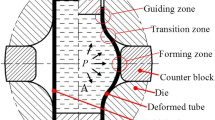Abstract
In a metal working process, the friction between the material and the tools influences the process by modifying the strain distribution of the workpiece. From a numerical point of view, a constant coefficient of friction (Coulomb’s friction) is commonly used in finite element simulations to model the frictional behaviour of contacting solids. However, friction coefficient varies in time and space with many parameters. We presented here a theoretical model of static friction in rubber/metal contact which allows the determination of the static coefficient of friction as a function of local contact conditions. Simulations using finite element software ABAQUS/Explicit were carried out for an axisymmetric tube bulging operation using the defined friction model. We compared the computed tube thickness related to the constant coefficient of static friction with the defined friction model. The results clearly showed that the new friction model provides better agreement between experiments (Girard, Grenier, Mac Donald, J Mater Process Technol 172:346–355, 2006) and results of numerical simulations.
Similar content being viewed by others
References
Thiruvarudchelvan S (1995) A software on sheet metal forming processes (A) with the aid of flexible tools, (B) using hydraulic pressure. J Mater Process Technol 48:699–705 doi:10.1016/0924-0136(94)01711-9
Thiruvarudchelvan S (2002) The potential role of flexible tools in metal forming. J Mater Process Technol 122:293–300 doi:10.1016/S0924-0136(02)00077-8
Mac Donald BJ, Hashmi MSJ (2002) Near-net-shape manufacture of engineering components using bulge-forming processes: a review. J Mater Process Technol 120:341–347 doi:10.1016/S0924-0136(01)01120-7
Kim J, Kim SW, Park HJ, Kang BS (2006) A prediction of bursting failure in tube hydroforming process based on plastic instability. Int J Adv Manuf Technol 27:518–524 doi:10.1007/s00170-004-2204-6
Girard AC, Grenier YJ, Mac Donald BJ (2006) Numerical simulation of axisymmetric tube bulging using a urethane rod. J Mater Process Technol 172:346–355 doi:10.1016/j.jmatprotec.2005.10.012
Pipan J, Kosel F (2002) Numerical simulation of rotational symmetric tube bulging with inside pressure and axial compression. Int J Mech Sci 44:645–664 doi:10.1016/S0020-7403(01)00094-7
Mac Donald BJ, Hashmi MSJ (2001) Three-dimensional finite element simulation of bulge forming using a solid bulging medium. Finite Elem Anal Des 37:107–116 doi:10.1016/S0168-874X(00)00023-8
Hwang YM, Lin YK (2002) Analysis and finite element simulation of the tube bulge hydroforming process. J Mater Process Technol 125–126:821–825 doi:10.1016/S0924-0136(02)00381-3
Yang B, Zhang WG, Li SH (2006) Analysis and finite element simulation of the tube bulge hydroforming process. Int J Adv Manuf Technol 29:453–458
Boumaiza S, Cordebois JP, Brunet M, Nefussi G (2006) Analytical and numerical study on plastic instabilities for axisymmetric tube bulging. Int J Mech Sci 48:674–682 doi:10.1016/j.ijmecsci.2005.12.012
Matuszak A (2000) Factors influencing friction in steel sheet forming. J Mater Process Technol 106:250–253 doi:10.1016/S0924-0136(00)00625-7
Lee BH, Keum YT, Wagoner RH (2002) Modeling of the friction caused by lubrication and surface roughness in sheet metal forming. J Mater Process Technol 130–131:60–63 doi:10.1016/S0924-0136(02)00784-7
Ramezani M, Ripin ZM, Ahmad R (2008) Modelling of kinetic friction in V-bending of ultra-high-strength steel sheets. Int J Adv Manuf Technol. doi:10.1007/s00170-008-1450-4
Benabdallah HS (2007) Static friction coefficient of some plastics against steel and aluminum under different contact conditions. Tribol Int 40:64–73 doi:10.1016/j.triboint.2006.02.031
Chang WR, Etsion I, Bogy DB (1988) Static friction coefficient model for metallic rough surfaces. J Tribol 110(1):57–63
Johnson KL (1997) A continuum mechanics model of adhesion and friction in a single asperity contact. NATO Sci Ser Ser E 330:151–168
Deladi EL, de Rooij MB, Schipper DJ (2007) Modelling of static friction in rubber–metal contact. Tribol Int 40:588–594 doi:10.1016/j.triboint.2005.11.007
Persson BNJ, Albohr O, Mancosu F, Peveri V, Samoilov VN, Sivebaek IM (2003) On the nature of the static friction, kinetic friction and creep. Wear 254:835–851 doi:10.1016/S0043-1648(03)00234-5
Deladi EL (2006) Static friction in rubber–metal contacts with application to rubber pad forming processes. PhD thesis, University of Twente, The Netherlands.
Hui CY, Lin YY, Baney JM (2000) The mechanics of tack: viscoelastic contact on a rough surface. J Polym Sci Part B Polym Phys 38:1485–1495 doi:10.1002/(SICI)1099-0488(20000601)38:11<1485::AID-POLB80>3.0.CO;2-1
Greenwood JA, Williamson JBP (1966) Contact of nominally flat surfaces. Proc R Soc Lond Volume A 295:300–319
Bureau L, Caroli C, Baumberger T (2003) Elasticity and onset of frictional dissipation at a non-sliding multi-contact interface. Proc R Soc Lond, Ser A, Math Phys Sci 459(1183):2787–2805
Sala G (2001) A numerical and experimental approach to optimise sheet stamping technologies: part II—aluminium alloys rubber-forming. Mater Des 22:299–315 doi:10.1016/S0261-3069(00)00088-1
Yu N, Pergande SR, Polycarpou AA (2004) Static friction model for rough surfaces with asymmetric distribution of asperity heights. ASME J Tribol 126:626–629 doi:10.1115/1.1739406
Author information
Authors and Affiliations
Corresponding author
Rights and permissions
About this article
Cite this article
Ramezani, M., Ripin, Z.M. & Ahmad, R. A static friction model for tube bulge forming using a solid bulging medium. Int J Adv Manuf Technol 43, 238–247 (2009). https://doi.org/10.1007/s00170-008-1708-x
Received:
Accepted:
Published:
Issue Date:
DOI: https://doi.org/10.1007/s00170-008-1708-x




